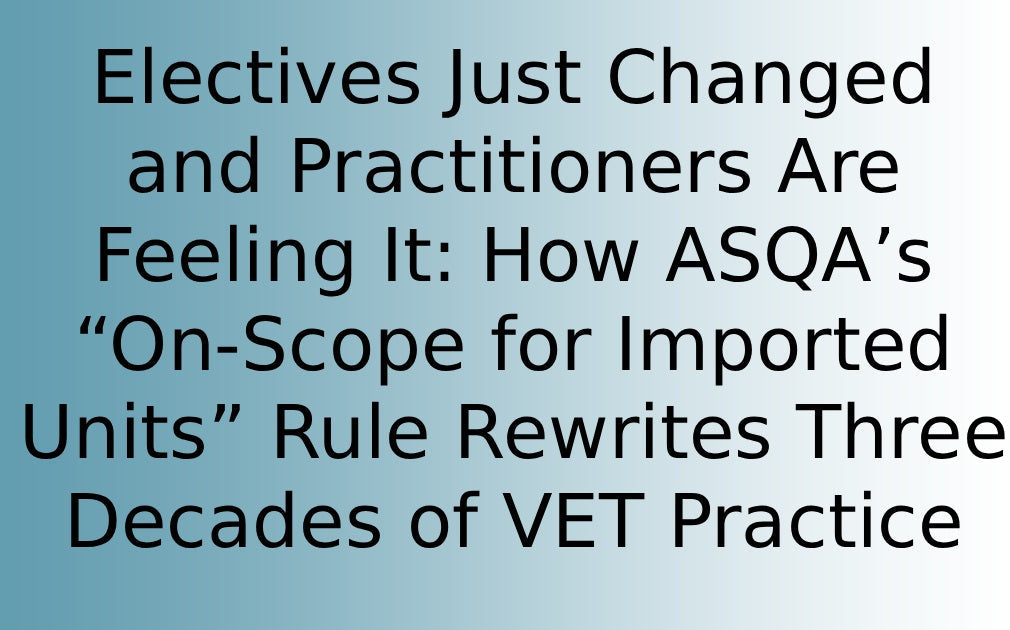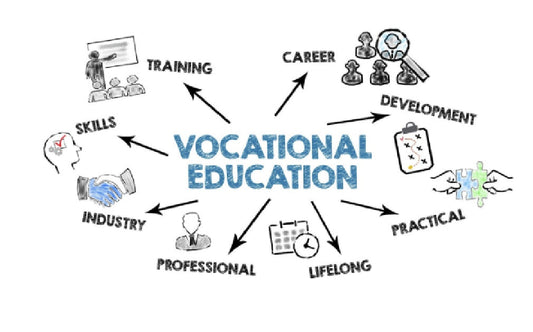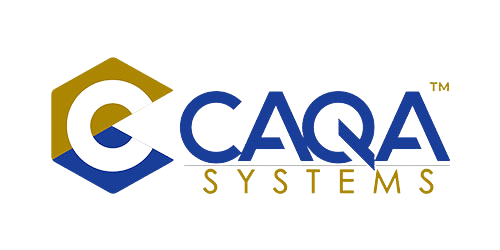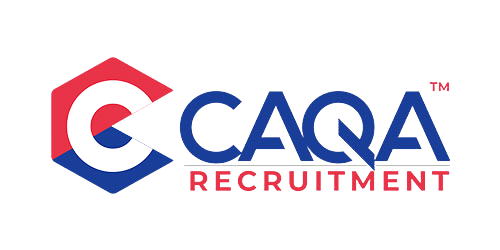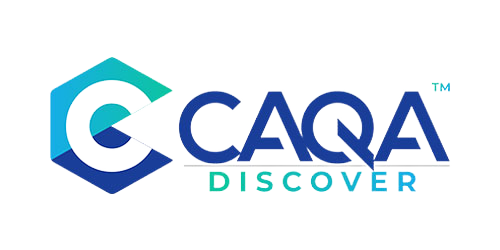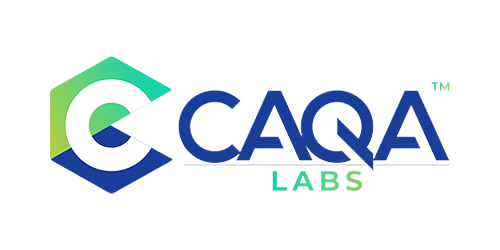The day ASQA published its 19 September 2025 fact sheet on delivering elective units, many people in Australian vocational education and training felt the ground shift under their feet. The document did not simply tidy up a technical ambiguity; it redrew a boundary line that has shaped how RTOs customise qualifications for real jobs since the 1990s. In clear and unambiguous terms, the national regulator has stated that when an RTO imports an elective unit of competency from outside the host training package, whether to place that unit inside a qualification or to offer it as a standalone, that unit must first be listed on the RTO’s scope of registration before any delivery or assessment occurs. In practical language, this means that the pathway from employer need to classroom now passes through the formal gate of a change of scope application, the submission of evidence that proves capability, and the completion of ASQA’s approval process. Sector veterans immediately recognised how different this position is from lived practice. Many practitioners have long relied on packaging flexibility and a professionally documented rationale to embed an imported elective quickly when it suited a workplace outcome, provided they could show the resources, the trainer's competence and a defensible assessment strategy. Some have even admitted that the flexibility in the rules created room for gaming at the margins, enrolling full qualification students, delivering only the imported bits that mattered for a job, and later withdrawing in order to claim a narrow outcome. The new fact sheet closes the door on both the legitimate nimbleness and the edge-case workarounds by coupling packaging flexibility to a bright, enforceable requirement that every imported unit be on scope before the first learner opens a workbook.
To grasp why the change feels so consequential, it helps to understand what has not shifted. Qualification packaging rules still allow electives to be drawn from other training packages or accredited courses, so long as the choices preserve AQF integrity, qualification relevance and viable vocational outcomes. The heart of customisation remains intact. What has changed is the licensing overlay that governs who is authorised to deliver what. In effect, ASQA has inserted a simple discipline step. If a unit is imported from another training package or from outside the approved list of named electives in the host qualification, the RTO must already be approved to deliver that unit and that approval must be visible on the national register. This is easy to say in theory and more demanding in practice, because it forces RTOs to align elective choice with scope status in real time. In the past, well-run providers could decide to satisfy a specific employer request by importing, provided their trainer held the competency, the equipment and facilities met the assessment conditions of the imported unit, the assessment tools were valid for the evidence profile in the unit, and the TAS explained the reasoning. Under the new position, the same provider must pause and ensure the unit is on scope before promoting, enrolling or assessing. The difference is time and certainty. The effect is a structural brake on speed to market, especially for employers who deal in short planning cycles and who expect the RTO partnership to move as quickly as the worksite.
A single example illustrates the human and operational contours of the new landscape. A program manager is running a Certificate III in Waste Management for a large council contractor. The employer asks that the program include a Chain of Responsibility unit from the TLI package because site supervisors are tightening compliance and want to raise awareness across work crews. The trainer already holds the unit, the RTO has trucks, load restraint equipment and a simulated environment sufficient for authentic evidence, and the rationale to import is watertight. Historically, the provider would proceed once the mapping was complete, the assessment tools were validated, and the TAS recorded the justification. Under ASQA’s current position, the provider must first add that TLI unit to scope, then commence delivery. In other words, the same careful argument and the same evidence of capability are still required, but they must now pass through a formal approval gate before the first class. For providers who built their reputation on employer-led tailoring within the national rules, this feels like a loss of responsiveness rather than a lift in quality. That sense of frustration is not simply about paperwork; it reflects a deeper worry that employers will disengage when the RTO cannot move at the pace of operational need, which is often measured in weeks rather than quarters.
To be fair to the regulator, there are serious reasons why the line was hardened. First, authenticity has always been a non-negotiable requirement for imported units. The assessment conditions of the source package must be met, the resources and equipment must be fit for purpose, and the trainer assessor must meet the qualifications and currency profile required by that unit. By tying delivery to scope status, ASQA is forcing those questions to the front of the conversation and ensuring they are answered before a single enrolment is processed. Second, integrity matters in a system that promises national recognition. While most practitioners used elective importing to solve real industry problems, a minority used the flexibility to claim breadth they could not properly support, or to run bolt-on units in ways that stretched the intent of the National VET Regulator Act and the Standards for RTOs. The new rule removes ambiguity in a way that is easy to audit. The message is simple. You can still customise, you can still respond to nuanced employer requests, but you must be registered for the unit you deliver, and you must be able to show that your people, your resources and your assessment strategy actually meet the specification.
The change has specific implications for standalone delivery. Many RTOs have carved out credible niches by offering individual units as short, targeted upskilling, often as part of workforce compliance programs. Under the new position, an RTO may only issue a Statement of Attainment for a single unit without listing it on scope when that unit is a core or a named elective in a qualification that is already on the RTO’s scope of registration. If the unit sits outside those bounded cases, it must be on scope in its own right before delivery. This boundary is sharper than the working assumption many have used, where a provider that already delivered the parent qualification could reasonably deliver and certify a unit from that family as a standalone. That assumption is no longer safe. The effect will be felt in every RTO that offers agile menus of elective options to small and medium employers because each imported elective is now a mini product that requires its own authorisation and dossier of evidence.
RTOs that operate in licensing-heavy markets will feel the weight most acutely. Licensing linked units, the classic Licence to Operate and similar outcomes, sit inside co-regulatory frameworks with their own conditions, supervisor hour requirements and assessor endorsements. Delivering such units without the full suite of approvals already carries significant risk to students who might discover that a Statement of Attainment did not translate into a licence. Under the new rule, providers must also ensure that the unit is on scope before any marketing, scheduling or delivery takes place. In practical terms, the safest approach is to build a single source of truth for licensing electives that records the relevant authority, the recognition pathway, the provider prerequisites, the equipment and facility requirements, the assessor endorsements, the supervised hour rules, and the proof that the unit appears on scope. This repository should feed into TAS development, marketing review, scheduling, trainer allocation and pre-issuance checks so that no cohort drifts into a unit with a hidden recognition trap.
The operational load is not imaginary. Change of scope applications require time, attention and evidence. The quality of the application matters much more than most people acknowledge in public. Strong applications anticipate the audit lens and present a coherent demonstration that the RTO understands the unit’s intent, has the right trainers and assessors with current industry currency and training and assessment credentials, owns or can access the equipment and facilities specified in the assessment conditions, and has developed a validation-tested assessment strategy that will generate valid, sufficient, authentic and current evidence. Applications that lean on broad statements or on generic capability without tying that capability to the precise requirements of the unit invite questions and delays. Providers who treat imported electives as mini products, with their own trainer CVs, PD logs, resource maps, assessment tool validation records and moderation plans, will move faster and build a repeatable internal standard. Providers who submit thin files and hope to backfill once classes commence will be frustrated, and their employers will be frustrated with them.
Beyond the mechanics of scope, the most immediate job for any RTO is to reconcile its elective menus with its scope register. This is unglamorous work. It begins with a full inventory of every elective currently offered across qualifications and every elective proposed for the next intake cycle. The exercise should flag imported units and match each one against the current scope. Where a unit is not on scope, the provider must decide to apply, substitute, or defer. That decision should be documented with the reasoning so that compliance and business teams are aligned, and so that sales and operations do not drift into promising what cannot be delivered. Marketing hygiene will need to improve. Public course pages should not promise electives that have not yet been approved. Where an RTO genuinely intends to seek approval and has reason to expect a decision before classes commence, it must communicate with care, ideally by explaining that elective options are subject to regulatory approval and by presenting default options that are already on scope. TAS documents should be updated to reflect the current state rather than wishful thinking, and internal schedulers must be trained to treat the scope check as a hard gate in the same way they would treat trainer availability or facility capacity.
None of this means abandoning employer partnerships or shrinking ambition. It means re-sequencing the work so that the regulatory authority is secured before the promise is made. That re-sequencing has knock-on effects that must be managed. Employer lead times should be reset. Where bespoke customisation depends on imports, RTOs must agree scope application windows up front and factor approval time into the delivery calendar. That conversation will test relationships in the short term, but it is better to negotiate lead time honestly than to scramble once a course is advertised or a training crew is booked onto the site. Batch applications can reduce administrative turbulence. Rather than lodging one-off scope changes in response to every small request, providers that prize elective variety can plan quarterly scope additions organised around a coherent theme, perhaps a family of units from a neighbouring package that aligns with a sector partnership strategy. Trainer professional development and currency activities can then be aligned to that forward plan, and validation schedules can be designed to include the newly approved units soon after first delivery so that assessment quality is checked early and improved quickly.
Risk management should be adjusted to the new reality. Many providers already include scope alignment somewhere in their internal controls. Under the new position, it should become a named risk with clear owner, controls and monitoring points. A mandatory scope checkpoint should sit before scheduling. A mid-term review should verify that no class has been timetabled or delivered in a unit that is not on scope, and a pre-issuance control should confirm that the certification being prepared corresponds to units that the RTO is approved to deliver and assess. Data systems can help, but they need careful configuration so that marketing, enrolment, scheduling and issuance all draw from the same authoritative register of scope. In mixed environments where CRICOS and domestic delivery co-exist, or where fee-for-service and funded programs overlap, the clarity that scope brings will reduce the chance of a cohort drifting into an unapproved combination.
The sector conversation about the new rule has been understandably emotional. People take pride in solving real employer problems quickly and in making the packaging rules work for learners who have a specific job goal. Case studies abound. A regional employer needs a short-notice elective so that crews can remain compliant under a refreshed company policy. A community health provider asks for a particular safety unit because an incident revealed a gap in understanding. A local government team wants to embed a transport and logistics unit inside a waste management program because vehicles are a significant hazard in their context. These are the kinds of problems that good VET practitioners have always solved without fuss. The important point is that these outcomes remain possible. The new reality is that elective innovation must be paired with scope stewardship. If you import it, you own it on scope, on paper and in delivery. That mantra will sound like a loss of agility to people who remember the reasonable justification era, but it is also a way to reduce the risk that well-intentioned nimbleness leaves a learner with a statement they cannot use or leaves an employer exposed when licensing scrutiny arrives.
There are unresolved questions at the edges that the sector will continue to surface. Providers want to know how the position interacts with legacy enrolments. If a cohort commenced under the previous working assumption and an imported unit is scheduled later in the delivery plan, what is the safest and fairest way to manage the transition? Providers are asking how credit transfer should be treated when a student brings an imported unit from a different RTO, and the home provider does not have that unit on scope. Others are seeking clarity on the treatment of units that are renamed or re-coded in training package updates when the intention is clearly equivalent, yet the scope register lags behind the change. These are the kinds of operational details that ASQA, JSA and the states will need to address in guidance and that peak bodies will continue to test. In the meantime, providers should assume that the fact sheet date is the operative date for audit expectations and that a conservative interpretation is safer than a creative one.
A deeper cultural shift sits beneath the mechanics of scope. The Australian system has long celebrated the flexibility of packaging rules as an employer-friendly asset. That flexibility is still there, but it is now yoked to a stronger expectation that authority and capability are proven before the promise is made. This is not a demand for reinvention. For high-performing RTOs, it is an invitation to anticipatory governance. Keep elective menus curated and scope-ready. Treat imported units as products with their own trainer, resource and assessment dossiers, and update those dossiers in line with currency and moderation findings. Socialise with employers that a customised elective now travels with an approval lead time and that the lead time protects both the employer and the learner by ensuring the evidence generated will stand up to audit and, where relevant, to licensing scrutiny. The discipline will feel heavy at first, and then it will become normal as systems catch up and teams internalise the new sequencing.
The most constructive way to interpret ASQA’s move is to see it as a signal that the regulator wants customisation to be real rather than rhetorical. Real customisation takes the unit of competency seriously. It respects the assessment conditions, it invests in trainer capability, and it designs tasks that elicit the evidence that the unit demands. When an RTO can show that level of seriousness in a well-prepared scope application, approval is more likely to be timely, and confidence is more likely to build over time. When an RTO treats importing as a convenience to be justified later, it puts its learners, its employers and its own licence at risk. The new rule is not the enemy of responsiveness. It is a hard invitation to do the design work early, to secure authority and to deliver with integrity.
Employers also have a role to play. The strongest partnerships will not treat the RTO as a vendor to be hurried but as a co-designer who must meet public obligations in order to protect the value of the credential in the wider labour market. Employers can help by engaging earlier, by sharing the evidence of the job requirement that justifies the import, by offering authentic worksites for assessment where appropriate, and by supporting co-assessment and post-placement feedback that improves the next iteration. In return, they will receive programs that stand up to scrutiny, that travel with their workers across sites and jurisdictions, and that reduce the need for repetitive in-house testing because the national signal remains clear.
Learners are the ones who pay the highest price when we get this wrong, so it is worth ending with their perspective. A student who completes an imported elective expects that the unit will be as real as any other. They expect that if they move interstate, the Statement of Attainment will be understood. They expect that if the unit links to licensing, the licensing body will recognise it. They trust the RTO to have done the homework and to have secured the approvals that make the credential meaningful. The new ASQA position, interpreted charitably, seeks to align system behaviour to that of learner expectations. It asks providers to stop pretending that a well-argued justification after the fact is good enough. It insists that the authority to deliver be settled before the student commits time and money. That insistence will feel tough for experienced practitioners who have used discretion wisely for a long time. It will also protect the credibility of the national system at a time when public trust is an asset we cannot afford to squander.
In the end, the message is not complicated. Elective importing is still permitted as a tool for relevance. It remains a way to bring the job into the classroom and to ensure that qualifications reflect the work that actually needs doing. The difference is that the door to this flexibility now opens through the house of scope, and the key is evidence that you are ready to deliver the unit as written, with the right people, the right resources and the right assessment. If you intend to import, plan ahead. If you promise an elective to an employer, be honest about approval timelines. If you deliver licensing-linked content, build a single source of truth that keeps you and your learners safe. If you market elective menus, keep them in lockstep with the register. If you manage risk, elevate scope alignment to a named control. Do these things, and you will find that the new discipline can coexist with a culture of responsiveness. Ignore them and you will discover that the same bright line that protects learners can also expose shortcuts you might once have gotten away with.
Australian VET has always been at its best when it moves with employers without losing sight of the public promise that a person’s skill should be recognised wherever they go. The 19 September 2025 fact sheet does not cancel that promise. It reminds the sector that the promise is only as strong as the evidence behind each unit and the authority each RTO holds to deliver it. The work now is to convert old habits of reasonable justification into new habits of scope stewardship. That shift will feel uncomfortable for a while, then it will become a mark of professional pride. When that happens, the phrase on scope will stop sounding like a brake and start sounding like a quality mark that tells learners and employers that the elective they care about is not just available, it is delivered with the authority, the equipment, the assessment and the currency that the unit requires. That is the future worth choosing, even if it asks all of us to slow down long enough to do the right thing in the right order.


